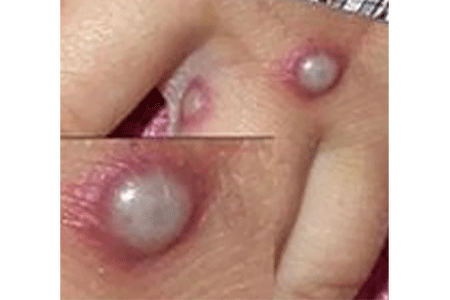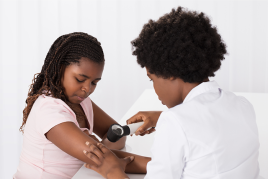Dermatologist explains what the mpox (monkeypox) rash looks like
Warning: Beware of products, including natural remedies sold to cure or prevent mpox (formerly known as monkeypox)
The U.S. Food and Drug Administration (FDA) approved the JYNNEOS® vaccine for preventing mpox. It is the only vaccine approved in the U.S. for this purpose. However, you may see other products that come with a claim that they can cure or prevent mpox.
The U.S. Food and Drug Administration (FDA) is warning consumers that:
The FDA has not reviewed any of these products or natural remedies sold to treat, cure, or prevent mpox.
These products and remedies, often sold online, have not been found safe or effective for treating mpox or other health conditions.
To protect your health, only use mpox treatment prescribed by your board-certified dermatologist or other medical doctor.
Most rashes that dermatologists are seeing at this time are not caused by mpox
Still, it’s important for you to be aware of mpox and get medical care if you develop a new rash with an unknown cause.

As reported cases of mpox grow, more patients are reaching out to their dermatologist about a new rash or bump on their skin. That’s a good thing.
The Centers for Disease Control and Prevention (CDC) now recommends that you "seek medical care immediately if you develop a new, unexplained skin rash or lesions on any part of the body." Just be sure to call ahead before going to a medical office. Mpox is contagious.
Here’s what else it can be helpful to know about mpox.
What is mpox?
Mpox is a contagious disease caused by a virus. This virus has been infecting humans since 1970, primarily in Africa, where outbreaks have occurred.
In the United States and Europe, where cases are now being reported, mpox outbreaks have been rare.
What are the signs and symptoms of mpox?
During past outbreaks, mpox started with a fever and often flu-like symptoms. A rash followed. The rash typically started on the face and spread to many areas of the body. People usually had between 10 and 150 pox-like bumps on their skin. Some people developed more than 200 bumps.
"This time, mpox looks different," says board-certified dermatologist Esther E. Freeman, MD, PhD, FAAD, Director, Global Health Dermatology, Massachusetts General Hospital, Harvard Medical School; Associate Director, Center for Global Health, Massachusetts General Hospital; and a member of the American Academy of Dermatology’s Mpox Task Force.
With this new outbreak, it's more common for people who get mpox to develop fewer bumps on their skin. They may not have a fever or flu-like symptoms.
What does the mpox rash look like?
"During this particular outbreak, we’re seeing that the rash may start in the groin, genital region, or around the anus – and sometimes stay in the spot that it started instead of spreading," says Dr. Freeman.
People may have only 1 or 2 bumps on their skin. These bumps can look like a blister, pus-filled bump, or open sore.
Even with a few bumps, the rash can be painful. Some people seek medical treatment for the painful rash.
Mpox causes pox-like bumps on the skin
In 2022, people may develop a few bumps instead of hundreds.

How do dermatologists know mpox is causing a rash?
"While the mpox rash can be mistaken for chickenpox, shingles, or herpes, there are differences between these rashes," says Dr. Freeman. By looking at the pattern on the skin and where the rash appears, a board-certified dermatologist can narrow down which disease is causing the rash.
If mpox is a likely cause, your dermatologist will swab the rash and send the swab to a lab. At the lab, a test known as a PCR (polymerase chain reaction) test will be performed. The results from the PCR test will indicate whether the swab contains the mpox virus.
How long does mpox last?
Most people have mpox for 2 to 4 weeks. That’s the amount of time it takes for the disease to run its course.
Until the bumps go away, a person who has mpox is contagious and can spread the virus to others.
How do you get mpox?
You develop mpox through close contact with an infected person or animal. Here’s how this happens:
An infected person: If someone has mpox, you can catch it if you:
Touch the rash or scabs or have intimate contact. This is the most common way to spread mpox.
Have prolonged face-to-face contact, as the virus can spread through respiratory droplets. This seems uncommon.
Touch an object that an infected person has used like unwashed clothing or bedding.
An infected animal: Animals infected with mpox are found in central or western Africa, where this virus is endemic (there all the time). Most of the infected animals are wild rodents like rope squirrels and dormice.
You can get mpox from an animal infected with the virus if you:
Are bit or scratched by the animal
Handle an infected animal (even a dead one)
Eat an infected animal
Use a product like a cream or powder made from an infected animal
Smallpox vaccine helps prevent mpox
If you have been vaccinated against smallpox, you have less risk of developing mpox.
The smallpox vaccine is approximately 85% effective in preventing mpox. However, many people, especially those under age 50, have not received this vaccine. The last routine smallpox vaccines were given in the United States in 1972 because smallpox had been eradicated (eliminated).
What should I do if I have symptoms of mpox?
If you have symptoms of mpox, call your doctor. Tell the person answering the phone that you have symptoms. Your doctor can determine what you should do.
The CDC is telling people, "If possible, call ahead before going to a health care facility"
If you are not able to call ahead, tell a staff member as soon as you arrive that you are concerned about monkeypox.

Dr. Freeman notes, "Not every new rash is mpox. However, if you do think you have mpox, it’s important to see your doctor quickly. Patients who delay getting medical attention may be diagnosed later when fewer treatment options are available. Waiting also means that you can expose more people to the virus, so family and others may develop mpox."
How is mpox treated?
People at risk of developing severe disease may receive treatment. Some antiviral medications are being used to treat people when the PCR test shows that they have mpox. There is currently no specific treatment approved by the U.S. Food and Drug Administration (FDA) for mpox.
Mpox is rare
As mpox is making its way around the world, it can seem like any new rash on your skin could be mpox. It’s important to remember that mpox is rare. Few people in the United States have developed this disease.
Still, some people are getting mpox. If you have a rash or bump on your skin and you don’t know what caused it, contact your board-certified dermatologist.
To find a board-certified dermatologist near you, go to Find a Dermatologist.
Related AAD resources
Mpox rash: Dermatologists' tips for treating your skin (Infographic)
Images
Images 1, 3: Getty Images
Image 2: Used with permission of the Centers for Disease Control and Prevention (CDC). This image is also available on the CDC website, and use of this image does not constitute endorsement or recommendation by the U.S. Government, Department of Health and Human Services, or Centers for Disease Control and Prevention.
References
American Academy of Dermatology, Recognizing monkeypox.” Page last updated June 1, 2022. Last accessed June 1, 2022.
Centers for Disease Control and Prevention (CDC):
Mpox. Page last updated January 6, 2023. Last accessed February 28, 2023.
Travel: Mpox. Page last updated August 29, 2022. Last accessed February 28, 2023.
U.S. Food and Drug Administration. “Illegally sold monkeypox products.” Content current as of 1/31/2023. Last accessed 2/20/2023.
U.S. Food and Drug Administration. “JYNNEOS.” Page last updated 9/2/2022. Last accessed 2/23/2023.
World Health Organization. “Monkeypox: Key facts.” Page last updated May 19, 2022. Last accessed June 6, 2022.
Written by:
Paula Ludmann, MS
Reviewed by:
Terrence A. Cronin, MD, FAAD
Esther Ellen Freeman, MD, PhD, FAAD
George J. Hruza, MD, MBA, FAAD
Toby A. Maurer, MD, FAAD
J. Klint Peebles, MD, FAAD
Adrian O. Rodriguez, MD, FAAD
Misha Rosenbach, MD, FAAD
Last updated: 2/28/23
 Molluscum contagiosum: How to safely treat it
Molluscum contagiosum: How to safely treat it
 Biosimilars: 14 FAQs
Biosimilars: 14 FAQs
 Practice Safe Sun
Practice Safe Sun
 Relieve uncontrollably itchy skin
Relieve uncontrollably itchy skin
 Fade dark spots
Fade dark spots
 Untreatable razor bumps or acne?
Untreatable razor bumps or acne?
 Laser hair removal
Laser hair removal
 Scar treatment
Scar treatment
 Botox
Botox
 Free materials to help raise skin cancer awareness
Free materials to help raise skin cancer awareness
 Dermatologist-approved lesson plans, activities you can use
Dermatologist-approved lesson plans, activities you can use
 Find a Dermatologist
Find a Dermatologist
 What is a dermatologist?
What is a dermatologist?